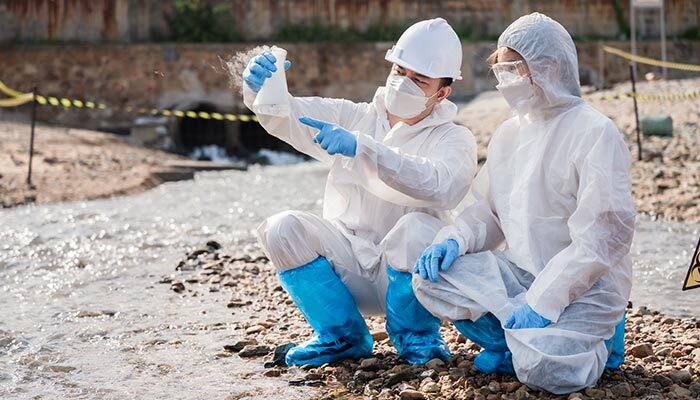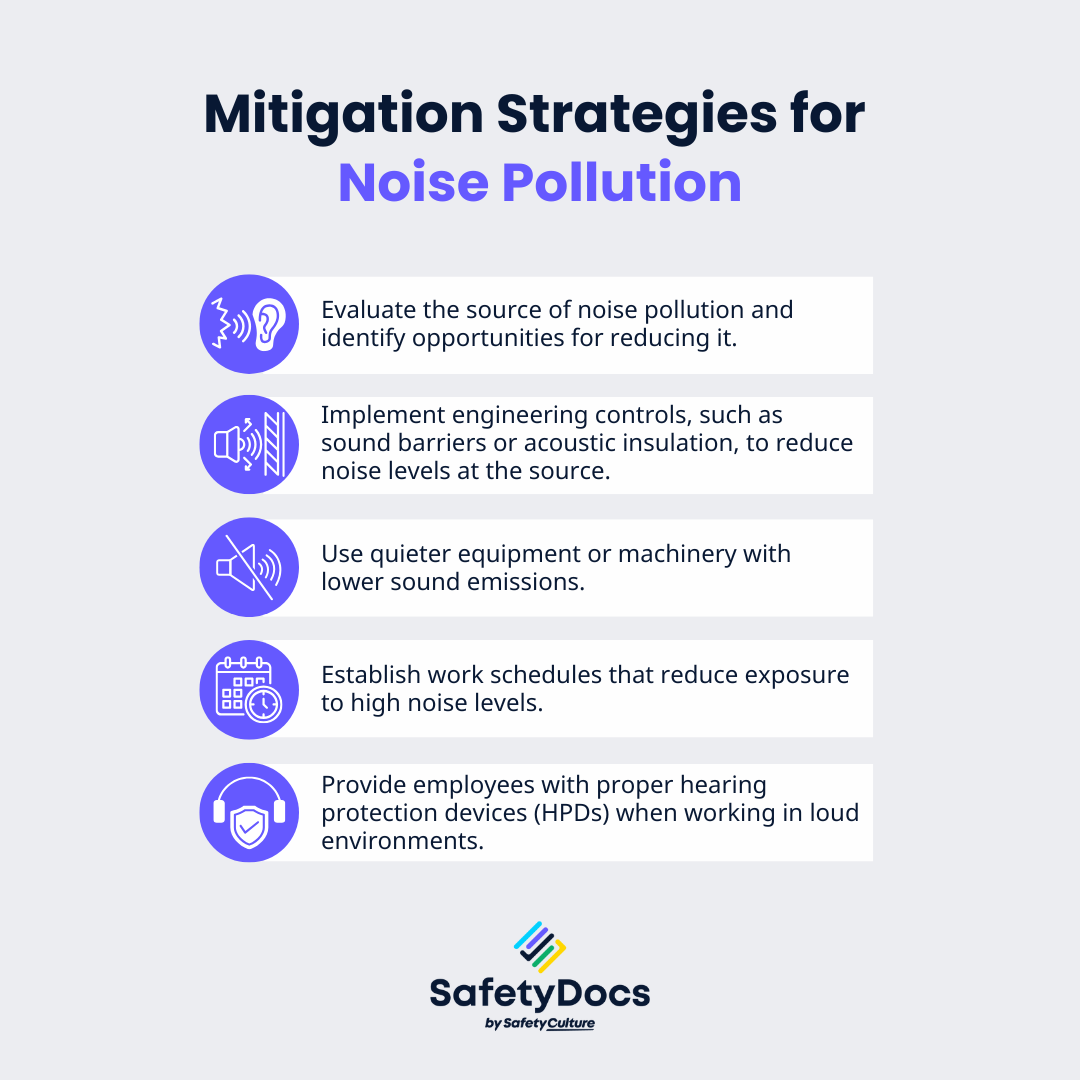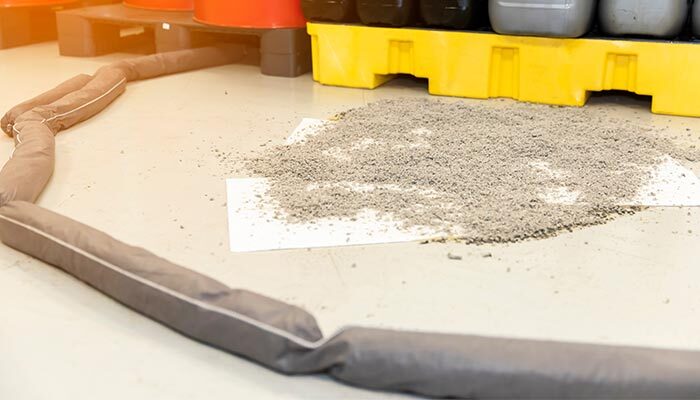Industrial operations encompass a wide range of sectors, including manufacturing, which is focused on the large-scale production of goods. These operations involve complex processes, supply chains, and technologies to convert raw materials into finished products. Due to the high number of work-related deaths and injuries, this industry is recognised as a national priority under the Australian Work Health and Safety Strategy 2012-2022.
Beyond worker safety, industrial operations also pose environmental risks that demand proactive, risk assessment and management throughout. This blog will discuss the ten common environmental risks associated with industrial operations and explore strategies to manage them effectively.
Risk Aspect 1: Air Pollution
Industrial operations in Australia are a significant source of air pollution, with primary metal manufacturing, coal mining, and electricity generation among the top contributors. Over 4,000 industrial facilities report emissions to the National Pollutant Inventory (NPI), highlighting the scale of the issue. Major pollutants include carbon monoxide (CO), volatile organic compounds (VOCs), sulphur dioxide (SO2), oxides of nitrogen (NOx), particulate matter (PM2.5 and PM10), lead compounds, benzene, toluene, formaldehyde, xylenes, and polycyclic aromatic hydrocarbons.
Impacts on Health
Rising demand for commodities has further driven an increase in certain pollutants. Airborne pollutants from industrial operations are known or suspected to cause grave health complications such as cancer, autoimmune diseases, nervous system conditions, and respiratory issues. They also lead to increased hospital admissions for respiratory conditions.
Addressing industrial air pollution is critical to mitigate environmental and health impacts, especially as economic growth drives demand in these sectors.
Mitigation Strategies
- Emissions Control: The primary approach to managing air pollution from industrial operations involves identifying and controlling the sources of emissions. Regulatory bodies, such as the Environmental Protection Authority (EPA), set emission standards, while the state requires works approval, licensing, and notices.
- Regulation of Air Pollution: The Australian government works with states and territories to improve air quality through National Environment Protection Measures, which set standards for monitoring and progress. The 2015 National Clean Air Agreement also introduced stricter emissions rules and a goal to reduce particle pollution.
- Air Quality Monitoring: Tracks pollution levels and compares them to standards. At industrial sites, real-time monitoring devices help protect workers' health and nearby communities.
Risk Aspect 2: Water Contamination
Industrial operations can release a wide array of pollutants into water bodies. It poses a threat to both surface water and groundwater resources. The specific pollutants vary depending on the industry, but some of the most common include:
- Petroleum Hydrocarbons: Released from oil refineries, storage sites, and spills.
- Heavy Metals: Lead, mercury, and cadmium from mining, manufacturing, and chemical industries.
- Surfactants: Found in detergents, soaps, and cleaning products used in industry.
- Per- and Polyfluoroalkyl Substances (PFAS): Synthetic chemicals used in industrial and consumer products.

Impacts on Ecosystems and Communities
Water contamination from industrial operations can have devastating impacts on both aquatic ecosystems and human communities:
- Aquatic Ecosystem Impacts: Pollutants can harm or kill aquatic animals and plants, leading to imbalances in food webs and the ecosystem's overall health. It can cause:
- Disruption of Food Webs
- Harm to Sensitive Species
- Algal Blooms and Hypoxia (depleted oxygen levels)
- Human Community Impacts: Contaminated water can cause health problems like skin irritation, breathing issues, and stomach illnesses. It also affects jobs in fishing and tourism that depend on clean water.
- Public Health Concerns: Untreated surface water contaminated by waterfowl can lead to outbreaks of highly pathogenic avian influenza (HPAI) in commercial poultry.
Mitigation Strategies
- Industrial Wastewater Treatment Plant Integration: Wastewater treatment plants integrate physical, chemical, and biological methods to remove pollutants and accommodate different processes.
- Safe Storage and Handling of Hazardous Materials: Proper storage, handling, and disposal of hazardous chemicals prevent spills that can contaminate water sources.
- Spill Response Plans: Developing and implementing spill response plans that outline procedures for containing and cleaning up spills.
- Regulatory Compliance: Adhering to all applicable environmental regulations and standards.
Risk Aspect 3: Soil Degradation
Soil degradation is a widespread environmental problem in Australia, impacting agricultural productivity, ecosystem health, and infrastructure. Industrial operations contribute to soil degradation through several pathways, such as:
- Deforestation due to land clearing for farming, infrastructure, wildfires, and drought
- Chemical spills, fuels, and other hazardous substances contaminate soil, making it infertile and toxic to plants and animals.
- Use of heavy machinery in farming and construction that compacts the soil
- Rising salinity, acidity, and reduced carbon levels due to poor soil management

Impacts on Agriculture and Ecosystems
Soil degradation has serious impacts on agricultural productivity and ecosystem health. Compacted and contaminated soil struggles to retain water, limiting crops' access to essential nutrients and reducing yields. Additionally, it threatens biodiversity by diminishing the variety of plants, animals, and microorganisms that depend on healthy soil for survival.
Mitigation Strategies
- Eliminate the Hazard: Outsource hazardous processes to companies equipped to handle them safely.
- Substitute the Hazard: Replace it with a safer alternative.
- Engineering Controls: Implement mechanical aids or assistive devices when possible. Install machinery safety guards, interlocks, and emergency stop buttons to prevent accidents.
- Management and Erosion Control: To mitigate soil erosion, use techniques such as conservation tillage, crop rotation, and cover crops. These practices help preserve the soil's structure and reduce runoff, preventing soil degradation.
- Personal Protective Equipment: Provide appropriate personal protective equipment (PPE) and ensure workers are trained in its proper use.
Risk Aspect 4: Hazardous Waste Disposal
Waste management companies often deal with hazardous materials like chemicals, e-waste, and medical waste. In Australia, strict state and federal laws regulate and control how hazardous waste is handled, from generation to transport, storage, treatment, and disposal, for example:
- Chemical Control Orders (CCOs): The NSW EPA can regulate a chemical's lifecycle under the Protection of the Environment Operations Act 1997.
- Dangerous Goods Compliance: Under Commonwealth law, compliance with dangerous goods requirements is mandatory if waste is classified as a dangerous good'.
- Hazardous Waste Act: The Hazardous Waste Act 1989 requires a permit from the Environment Minister to move hazardous waste in or out of Australia. Doing so without a permit is illegal and carries heavy penalties.
Health and Safety Concerns
People handling disposal face risks like toxic exposure and physical injuries. They could face legal action and fines for breaking regulations.
Mitigation Strategies
- Safely collect, segregate, and label hazardous waste.
- Partner with certified waste management facilities for proper disposal.
- Train employees to handle dangerous materials following best practices.
- Innovate processes to minimise hazardous by-products altogether.
Risk Aspect 5: Noise Pollution
Industrial noise pollution, characterised as unwanted or excessive sound from industrial activities, poses significant challenges across various sectors. Sources include:
- Machinery, equipment and tools used in manufacturing or construction
- Transportation vehicles such as trucks, ships, planes and rail cars
- Power generation plants and factories
Impacts on Human and Animal Health
Exposure to noise pollution can lead to various adverse health outcomes, including:
- Hearing Damage: SafeWork Australia notes that employees should not be exposed to noise levels exceeding 85 dB over an average work shift of eight hours or a cumulative 40-hour workweek. Additionally, noise levels above 140 dB should be avoided as they can result in immediate harm.
- Physical and Mental Health: Prolonged exposure to industrial noise can cause stress, sleep disturbances, and other health issues.
- Impacts on Animals: Noise pollution can disturb wildlife, affecting their behaviour and habitats.
Mitigation Strategies
- Evaluate the source of noise pollution and identify opportunities for reducing or eliminating it.
- Implement engineering controls, such as sound barriers or acoustic insulation, to reduce noise levels at the source.
- Use quieter equipment or machinery with lower sound emissions.
- Establish work schedules that reduce exposure to high noise levels.
- Provide employees with proper hearing protection devices (HPDs) when working in loud environments.

Risk Aspect 6: Energy Overuse
Excessive energy use harms the environment by causing air pollution, water degradation, and land changes. Most energy comes from burning fossil fuels, which releases greenhouse gases and worsens climate change. Growing energy demands increase these effects, threatening ecosystems, wildlife, and human life.
Mitigation Strategies
- Measure and Benchmark Energy Consumption: Tracking and analysing energy use data can identify problem areas, inform improvement targets, and monitor progress.
- Implement Energy-Saving Strategies:
- Upgrade to energy-efficient equipment and appliances.
- Use renewable energy sources, such as solar power.
- Encourage employees to practice energy conservation measures, such as turning off equipment when not in use.
- Implement energy-saving initiatives, such as lighting and HVAC system retrofits.
- Implement Smart Manufacturing Technologies: Automation and data analytics can reduce energy use by optimising processes, reducing waste, and improving efficiency.
- Invest in Employee Training and Awareness: Educating employees on the importance of energy conservation and providing training on efficient practices can help drive behaviour change.
Risk Aspect 7: Biodiversity Loss
Australia faces a critical biodiversity crisis, with over 2,000 species and more than 100 ecological communities at risk of extinction. Tragically, the nation holds the world’s highest rate of mammal extinctions. The major causes of biodiversity loss include habitat destruction and fragmentation due to land clearing for agriculture and urbanisation.
Conservation Measures
Organisations can help protect and restore biodiversity by:
- Implementing Sustainable Land Use Practices: Adopting sustainable practices such as regenerative agriculture and responsible land management can help reduce the impact of land development on biodiversity.
- Supporting Conservation Efforts: Partner with environmental organisations to protect or restore habitats, support species recovery programs, and conserve ecosystems.
Risk Aspect 8: Greenhouse Gas Emissions
Human activities like burning fossil fuels for energy, transport, and industry release carbon dioxide (CO₂) and other greenhouse gases. In NSW, most emissions come from electricity generation (38%), followed by transport (20%), agriculture (12%), industrial processes (9%), and leaks from coal and gas (9%).
Regulatory Measures
- Starting January 1, 2025, Australia's biggest companies could be required to report climate risks, opportunities, and scope 1 and 2 Greenhouse gas (GHG) emissions.
- Australia aims to reduce GHG emissions by 43% from 2005 levels by 2030 and achieve net zero by 2050.
Risk Aspect 9: Chemical Spills
Uncontrolled chemical spills can pose serious risks to human health, the environment, and property. Chemicals, whether in liquid, solid, or gas form - such as corrosive gases, toxic liquids, or flammable solids - can cause significant harm. These substances have the potential to contaminate air, soil, and water sources, including groundwater, causing widespread environmental damage.
Emergency Response Measures
- Have emergency response protocols in place, including training for spill preparedness and clean-up procedures.
- Implement proper storage and containment measures to prevent chemical spills from occurring.
- Regularly inspect containers and equipment that contain hazardous chemicals for damage or wear and tear that could lead to spills.
- Provide personal protective equipment (PPE) to workers handling hazardous substances.

Risk Aspect 10: Resource Overuse
Ecosystems are unable to cope with excessive resource extraction. Overuse of resources such as water, timber, minerals, and land results in severe ecological damage. This loss can be irreversible and disrupt the balance of ecosystems, affecting both humans and wildlife.
Real-World Examples
- Mining Industry: Mining operations heavily contribute to resource depletion. It drives deforestation, soil erosion, and water pollution. For example, cobalt mining - crucial for electric vehicle production - frequently results in significant loss of green cover and poses serious health risks to nearby communities.
- Fashion Industry: The fashion industry consumes vast amounts of water, energy, and chemicals to produce clothing, much of which is discarded in landfills after only limited use.
Mitigation Strategies
To address the overuse of resources, organisations can:
- Adopt Sustainable Resource Management Practices: Implement sustainable resource management strategies to reduce waste and promote the benefits of the circular economy.
- Invest in Alternative Materials and Technologies: Use renewable materials and cleaner production technologies to mitigate negative impacts on the natural environment and the ecosystem.
Take Action to Manage These Risks With SafetyDocs
Identifying and managing environmental risks is key to staying compliant, supporting sustainability, and working safely. Proactive strategies protect the environment and safeguard your business. What can you do? Take the first step toward safety with SafetyDocs by SafetyCulture.
Are you confident that your environmental management strategies are as effective as they should be? If not, we’re here to help. Explore our solutions designed to enhance your environmental risk management practices and help you easily identify, assess, and mitigate potential environmental risks in your organisation.
Discover our safety documents:
Share This Article
